Physical Address
304 North Cardinal St.
Dorchester Center, MA 02124
Physical Address
304 North Cardinal St.
Dorchester Center, MA 02124
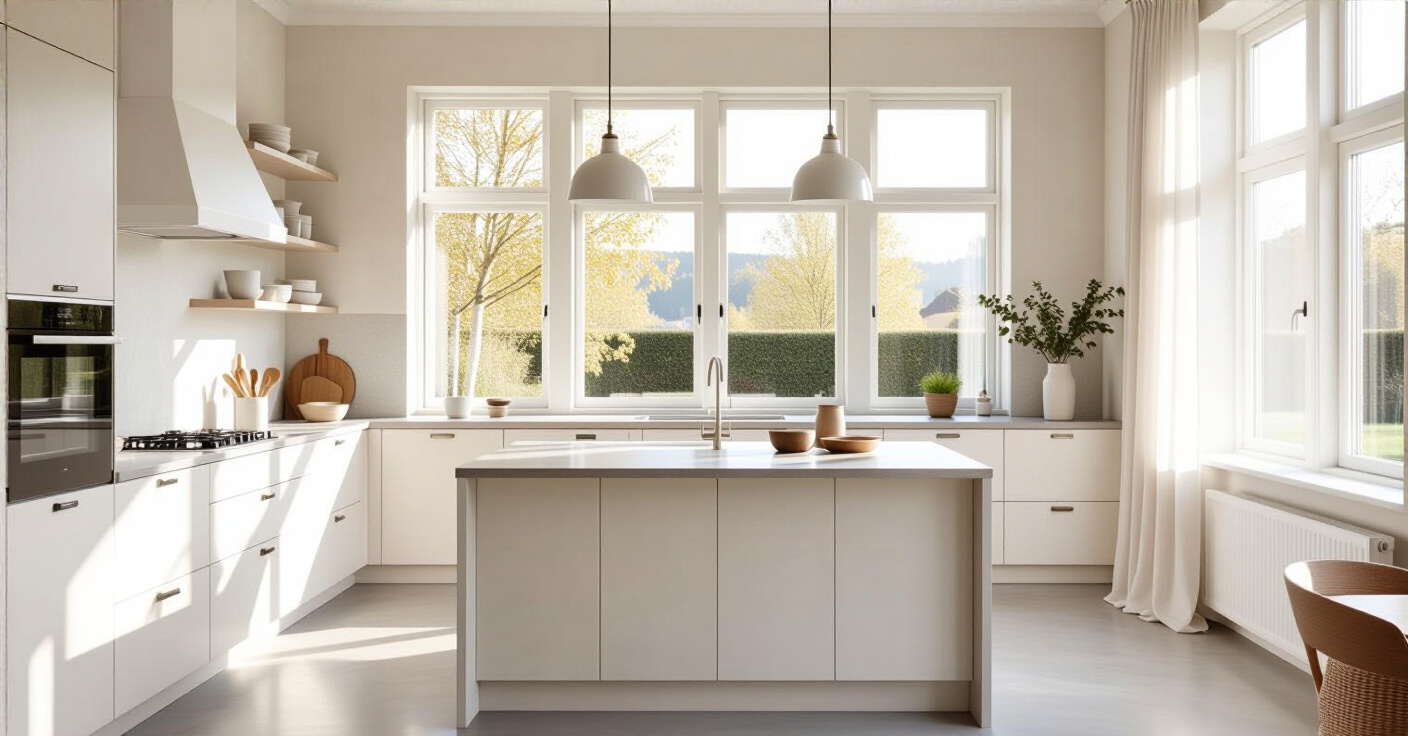
Discover 24 essential ways to create a serene Scandinavian kitchen. This guide helps you design a calming, functional space that supports your well-being.
You know what people always ask me? They’ll show me a picture of a pristine, white kitchen and say, “Is this it? Is this the calm I’m looking for?” And I gently tell them that a picture of a Scandinavian kitchen is like a picture of a person meditating. You’re seeing the result, but you’re missing the whole point—the practice behind it.
A truly serene kitchen isn’t just about white paint and light wood. It’s about creating a space that gives your mind a place to rest. It’s a visual sigh of relief. It’s a room that works with you, not against you, so you can focus on nourishing yourself and the people you love. Forget the corporate speak and the complicated design rules. Let’s talk about how to create that feeling in your own home, one simple, mindful choice at a time.
This is the bedrock. It’s not about trends; it’s about the philosophy. If you get this part, everything else falls into place naturally. It’s the ‘why’ behind every choice you’ll make.
Let’s be real, light is everything. In the Nordic countries, where this style was born, winter means very little daylight. So, their entire design philosophy is built around capturing every last drop of it. It’s not just about seeing better; it’s about feeling better. Abundant natural light makes a space feel bigger, cleaner, and more optimistic.
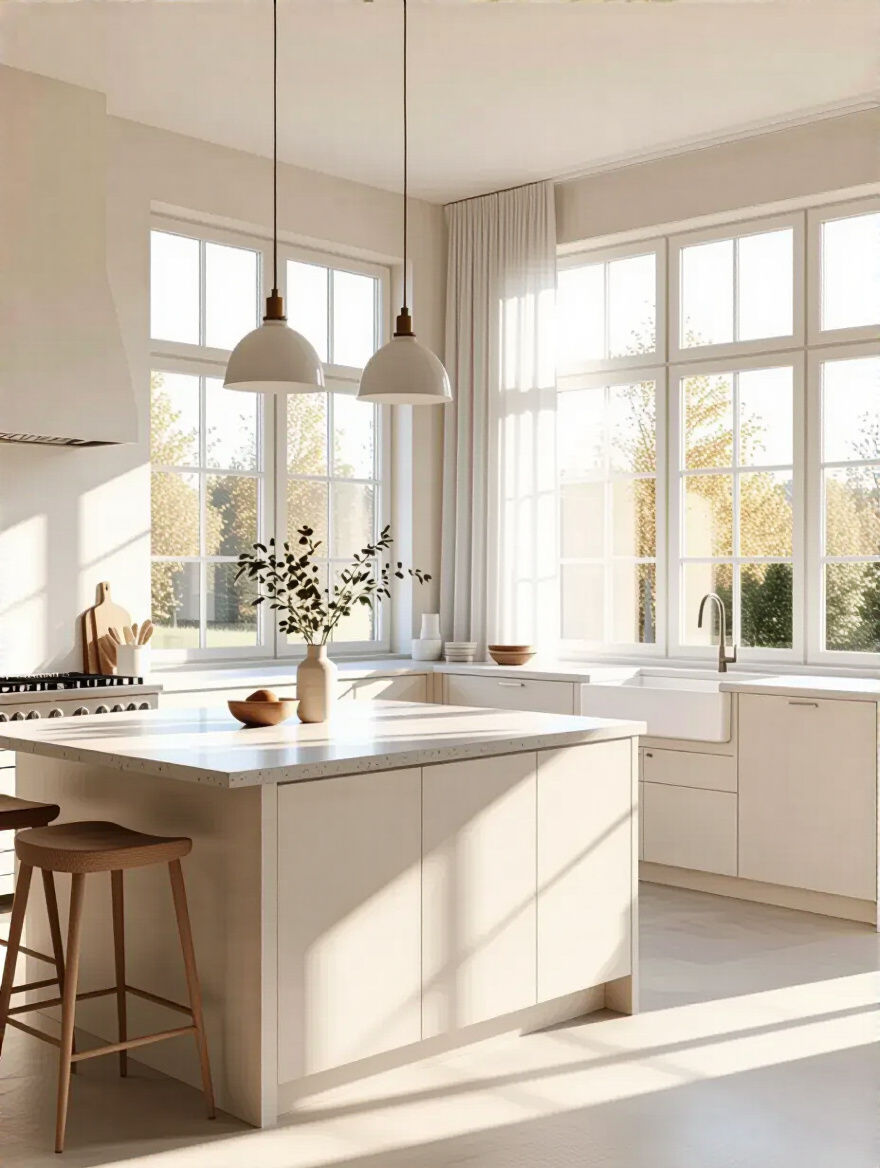
The mistake people make is thinking this just means painting the walls white. That helps, but the real secret is in what you don’t do. Don’t block your windows with heavy curtains. Don’t fill the space with dark, bulky furniture that swallows the light. Let the sunlight be the main event, and everything else is just a supporting actor.
This is your foundation. Get the light right, and you’ve already won half the battle for a peaceful space.
This is just a fancy way of saying, “give your eyes a place to rest.” Our brains are constantly processing information, and a visually busy space is exhausting. Clean lines—from simple, unadorned cabinet fronts to sleek countertops—reduce that sensory input. Your mind doesn’t have to work so hard, so you feel calmer without even knowing why.
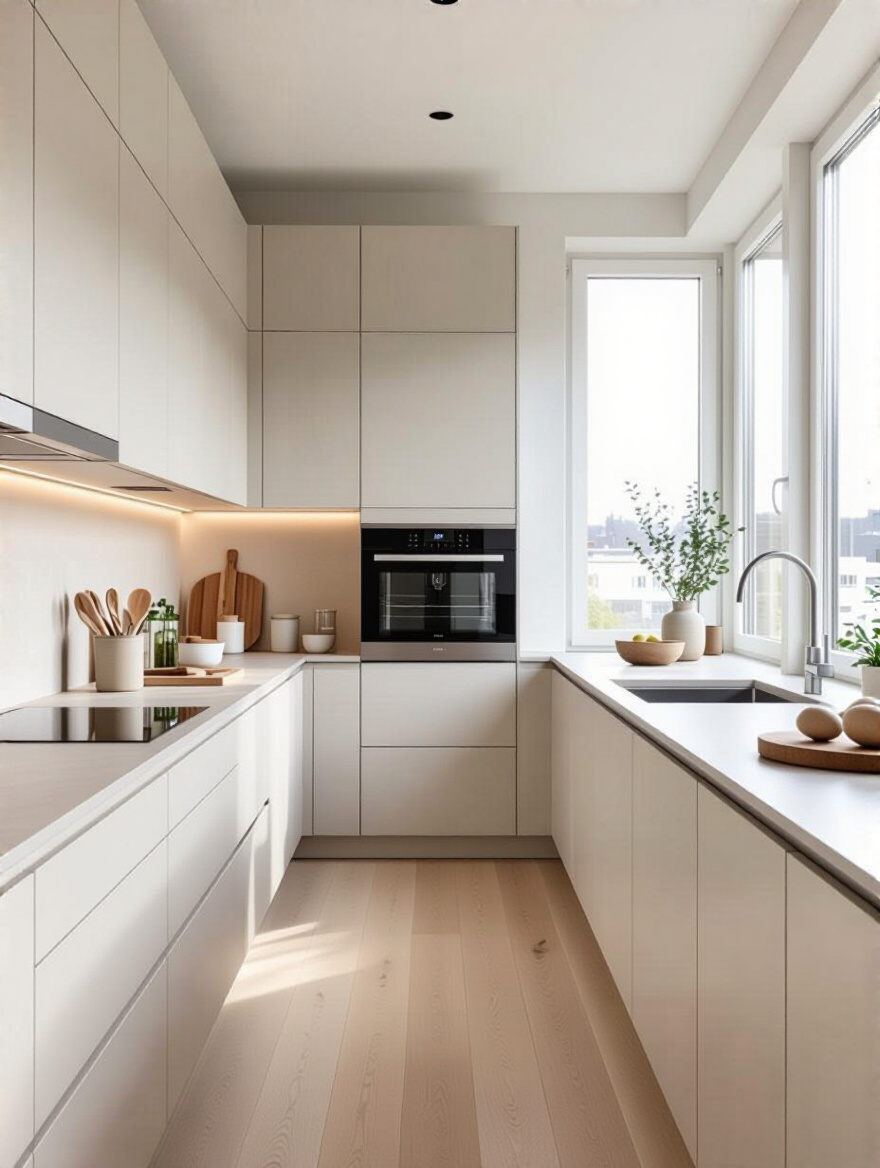
Think of it as visual silence. This is why you see so many handle-less cabinets in Scandinavian design, using push-to-open mechanisms or integrated pulls. It’s one less thing to look at. The big shortcut here is realizing you don’t have to rip out your kitchen. Start by clearing your countertops. Leave out only what is both beautiful and useful. That act alone creates an incredible sense of order and calm.
From this visual calm, we can move into making the space work for you, not against you.
A beautiful space that doesn’t work is just a museum. A Scandinavian kitchen is designed to be lived in, and that means it has to be effortless. Ask yourself: does your kitchen flow with you, or does it fight you every step of the way? Can you move from the fridge to the sink to the stove without running a marathon?
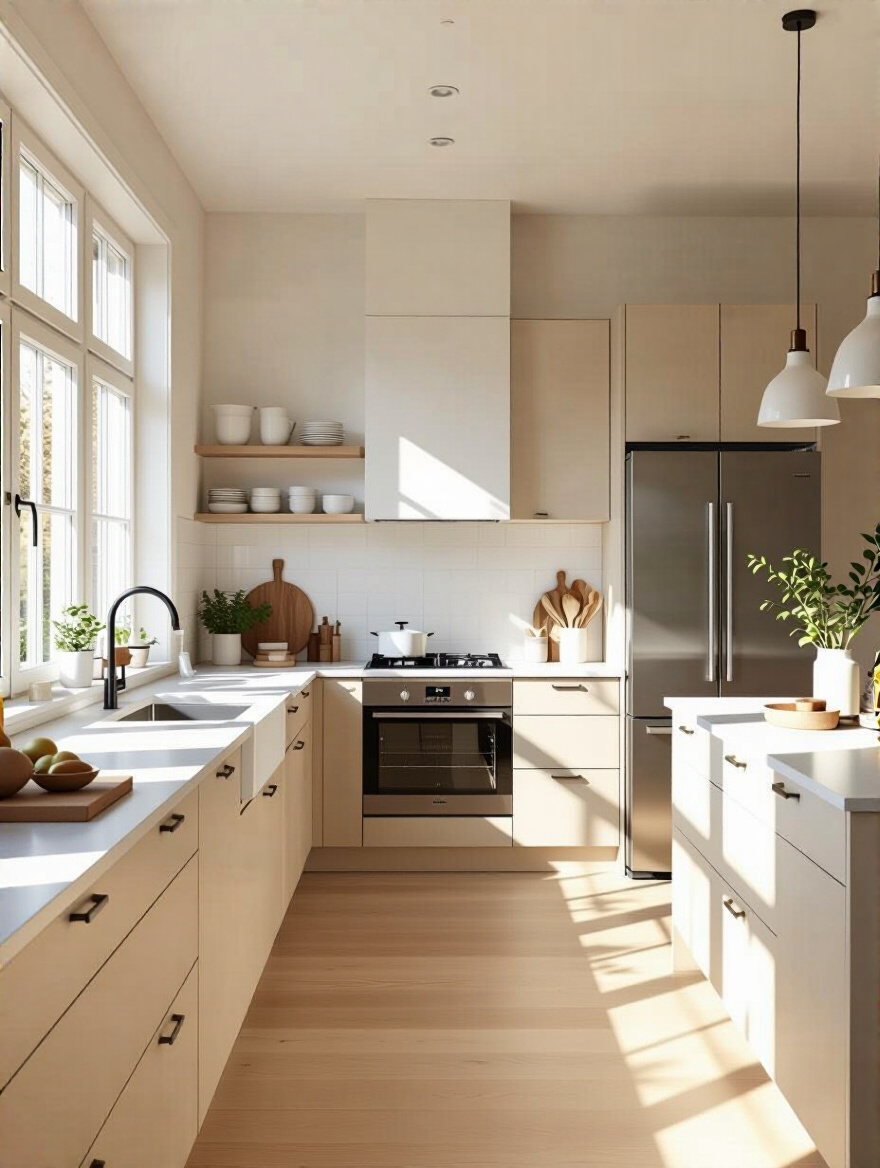
I once had a client who had a gorgeous kitchen, but her mugs were on the opposite side of the room from her coffee machine. A tiny thing, but every single morning started with a moment of unnecessary friction. We simply moved the mugs, and it changed her whole morning ritual. That’s the core of this principle. Your kitchen should feel like a quiet, supportive partner, not a demanding boss.
And this feeling of ease is beautifully supported by a quiet color palette.
Here’s where people get it wrong. They see “minimalist palette” and think it means cold, boring, or sterile. Absolutely not. The real goal is to create a calm, cohesive backdrop so that the life in the kitchen—the people, the food, the a-few-well-chosen-objects—can be the star. The palette is the canvas, not the painting.
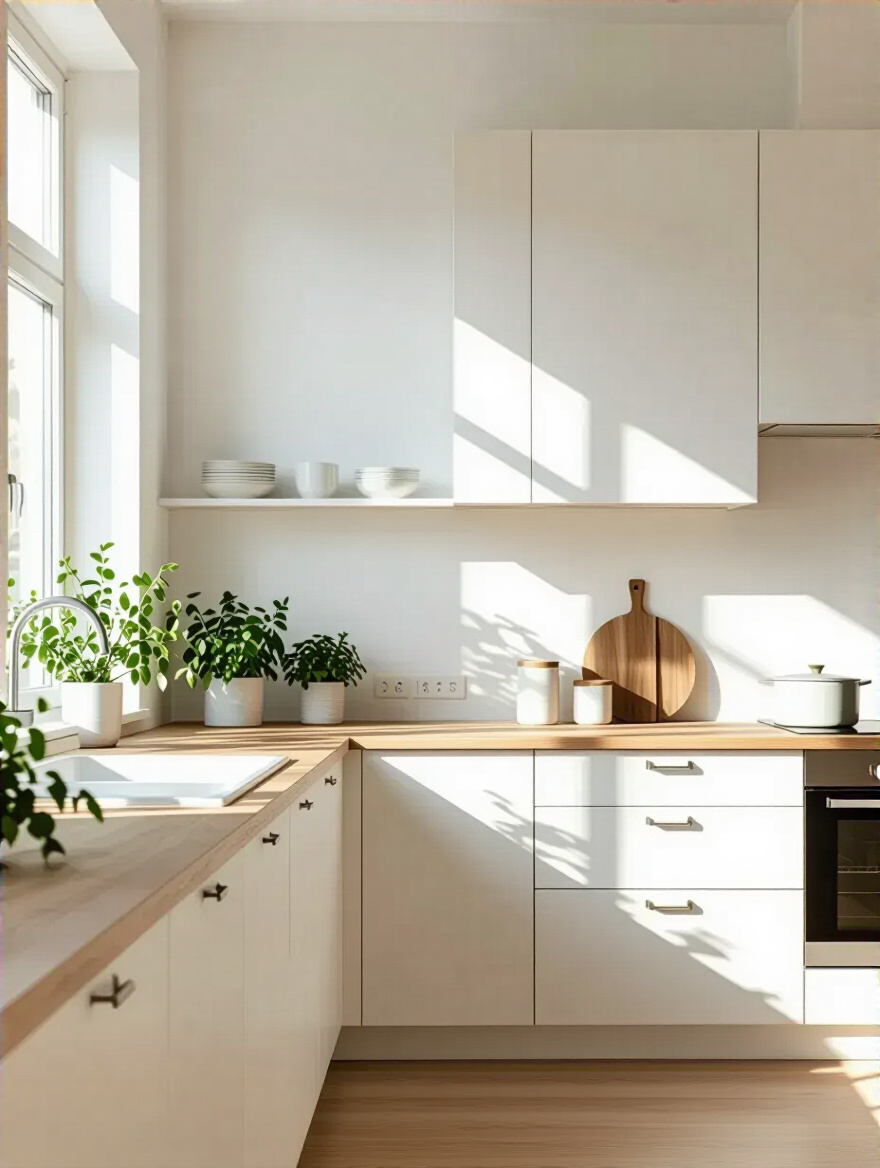
I once consulted with a client who went all-in on brilliant white for everything—walls, cabinets, floors. The result felt like a laboratory. It was blinding. The secret is to layer different shades of whites, soft grays, and muted, nature-inspired tones. And most importantly, you have to bring in warmth through texture, which we’ll get to. A quiet palette isn’t about the absence of color; it’s about the presence of peace.
This mindset of “just enough” is a philosophy in itself.
If you only remember one new word, make it lagom. It’s a Swedish concept that means, “not too much, not too little—just right.” It’s the Goldilocks principle of design. It’s the opposite of our consumer culture that tells us we always need more. Lagom asks, “What do I truly need to make this space work beautifully and feel good?”
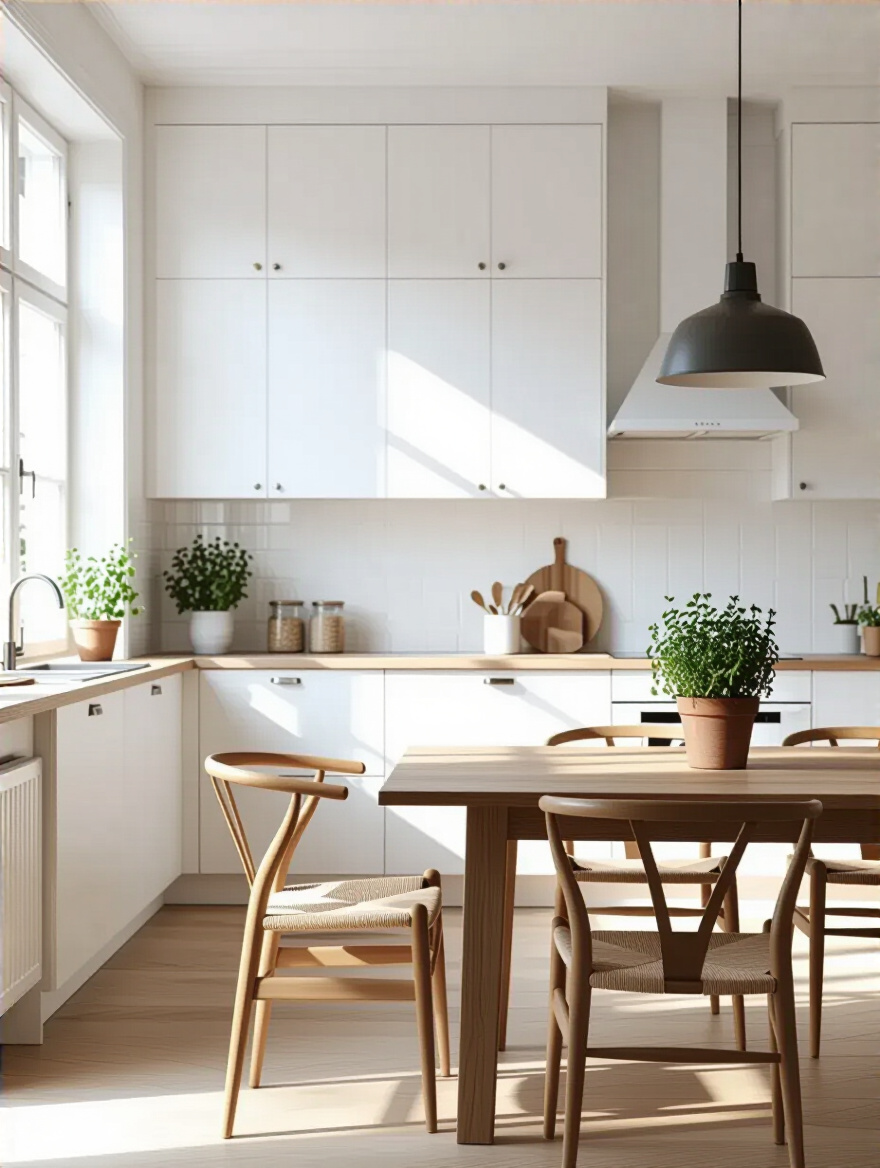
It’s not about stark minimalism or deprivation. It’s about being intentional. A lagom kitchen might have just one set of beautiful, high-quality knives instead of a messy drawer full of mediocre ones. It’s choosing one perfect armchair for the corner instead of filling it with clutter. It’s about finding that sweet spot of perfect sufficiency, which is the most sustainable and calming way to live.
This philosophy of mindful selection extends directly to the materials you bring into your home.
This is where your kitchen gets its soul. The way things feel to the touch is just as important as how they look. We’re moving beyond the visual to the tactile, bringing in warmth and authenticity.
Light woods like oak, ash, and birch are the heart of Scandinavian design. Why? Because they do two things perfectly: they reflect that precious light we talked about, and they bring the natural world inside. In a minimalist space, wood provides organic warmth and texture that keeps the room from feeling cold. It’s a connection to nature that is grounding and deeply calming.
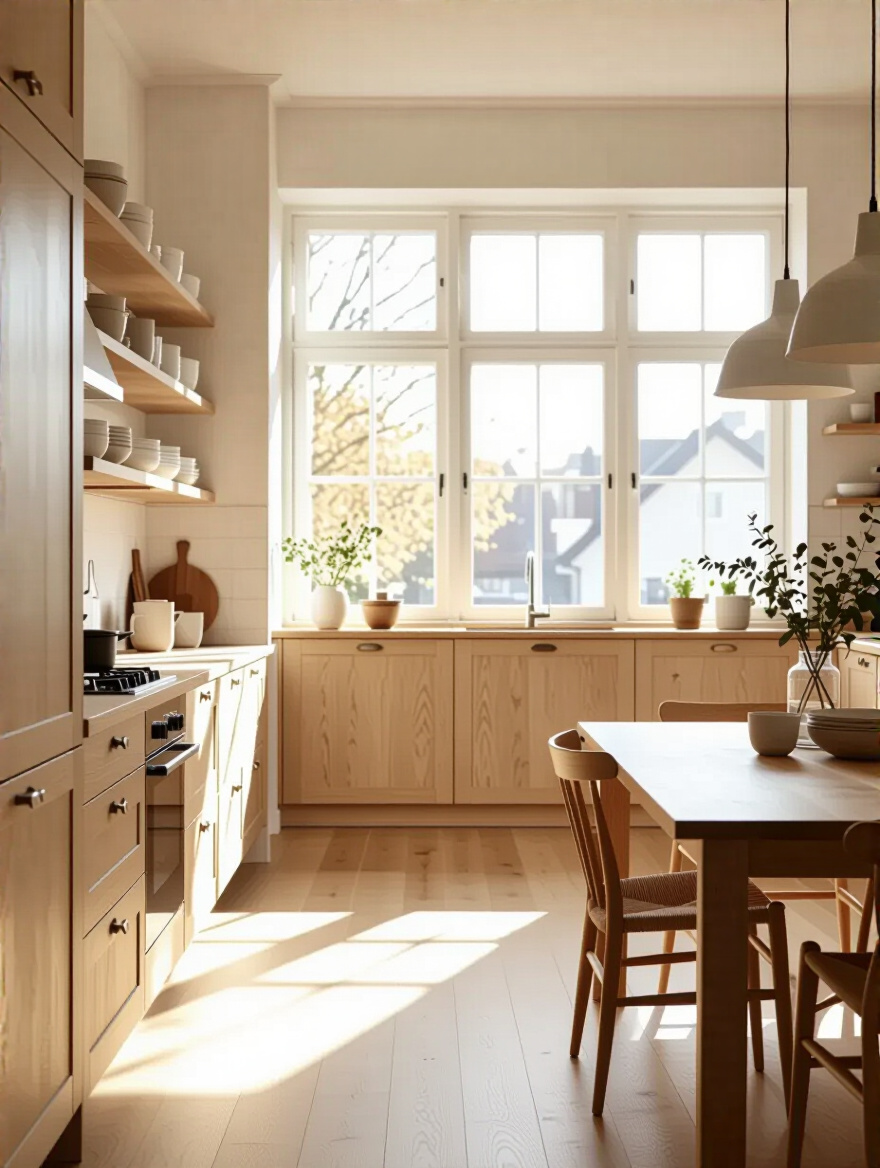
There’s an honesty to solid wood. You can feel its strength and see its history in the grain. This is the antidote to the cold, clinical look. The BS everyone falls for is cheap, plastic-y laminate that looks like wood but feels dead to the touch. If you can, invest in even one real wood element—a cutting board, a stool, a set of shelves. The authentic warmth it brings is immeasurable.
To complement this natural warmth, let’s talk about the surfaces that surround it.
This is one of my favorite secrets because it’s so simple but makes a huge impact. Think about the difference between a loud, shiny surface and a quiet, soft one. High-gloss finishes bounce light around in a chaotic, distracting way. Matte finishes, on the other hand, absorb it. They diffuse the light, creating a soft, velvety look that is incredibly calming.
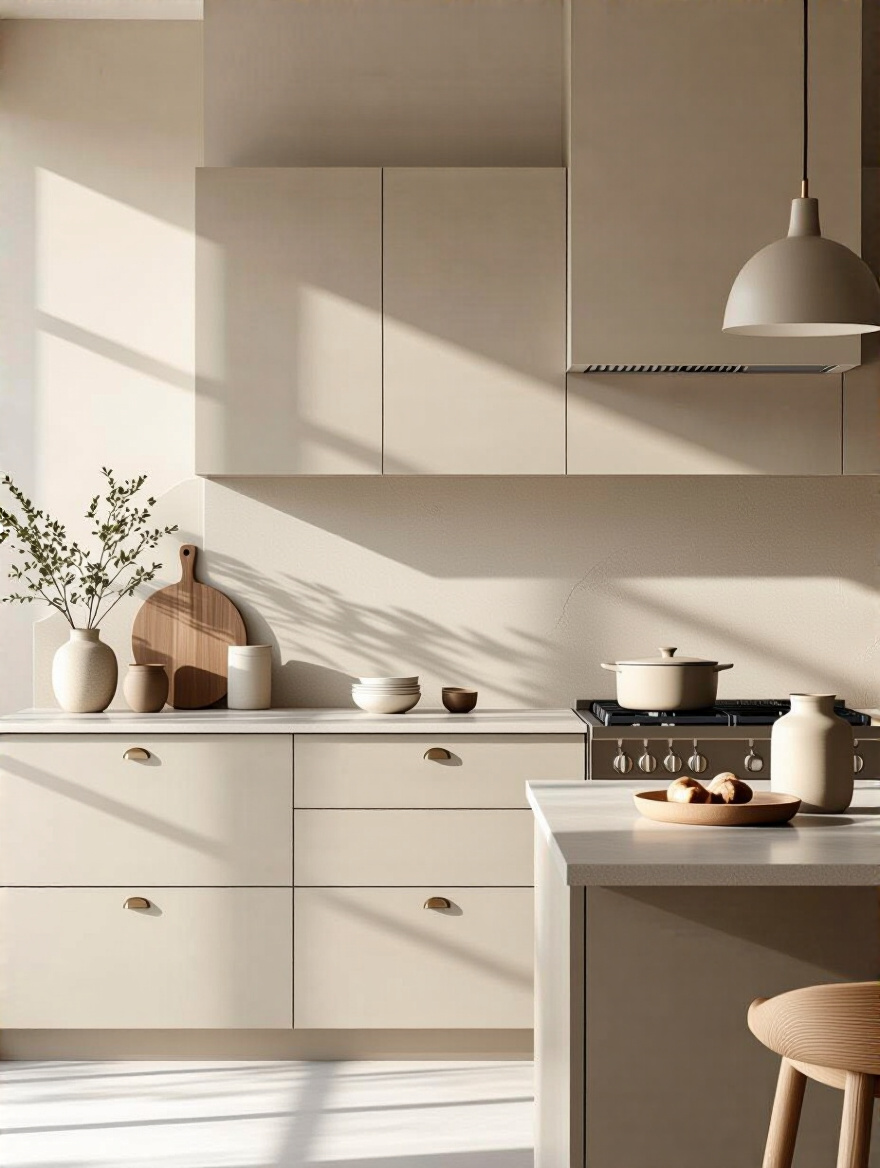
It’s an instant upgrade for the senses. Matte surfaces also hide fingerprints better, which means less cleaning and less visual “noise” from smudges. You can bring this in easily. Swap your shiny chrome cabinet pulls for matte black or brushed brass ones. Choose an eggshell or matte paint finish instead of a satin one. It’s a small change that brings a deep sense of sophisticated, quiet luxury.
Now, let’s add another layer of natural, grounding texture.
If wood is the warmth, stone or concrete is the anchor. These materials bring a sense of history, gravity, and elemental strength to your kitchen. A smooth, cool-to-the-touch concrete countertop or a subtly veined marble backsplash provides a beautiful contrast to the softness of wood and the clean lines of the cabinetry.
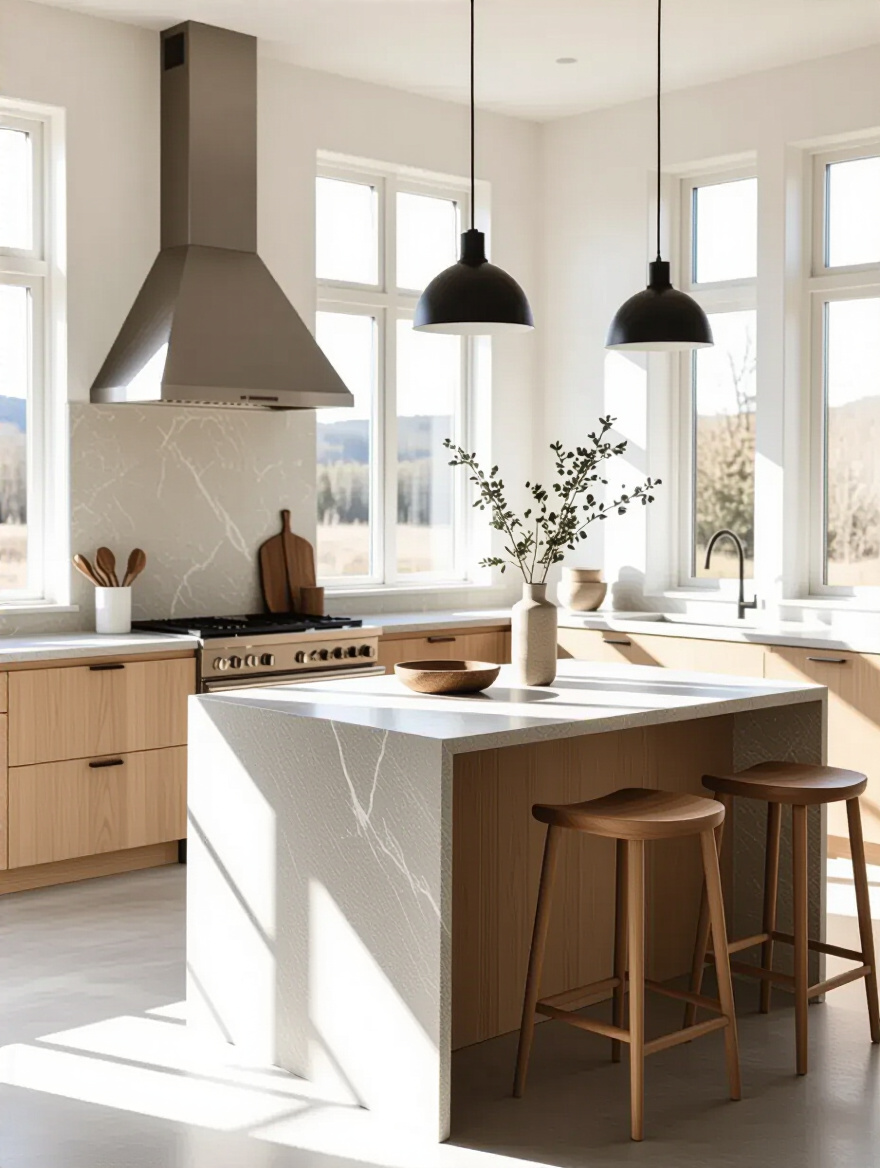
This is all about tactile balance. Too many hard, smooth surfaces can feel sterile. Too many soft textures can feel cluttered. The interplay between them is what creates a dynamic, interesting space that still feels serene. A common mistake is to go for a highly polished, flashy stone. The real beauty is in a honed or raw finish that celebrates the material’s natural, imperfect texture.
This perfect texture is also key when choosing something as simple as a tile.
The simple white subway tile is a classic for a reason. It’s a workhorse. It’s humble, functional, and clean. It reflects light beautifully and provides a quiet, gridded texture that doesn’t scream for attention. It’s the perfect backdrop, allowing your other design choices to shine.
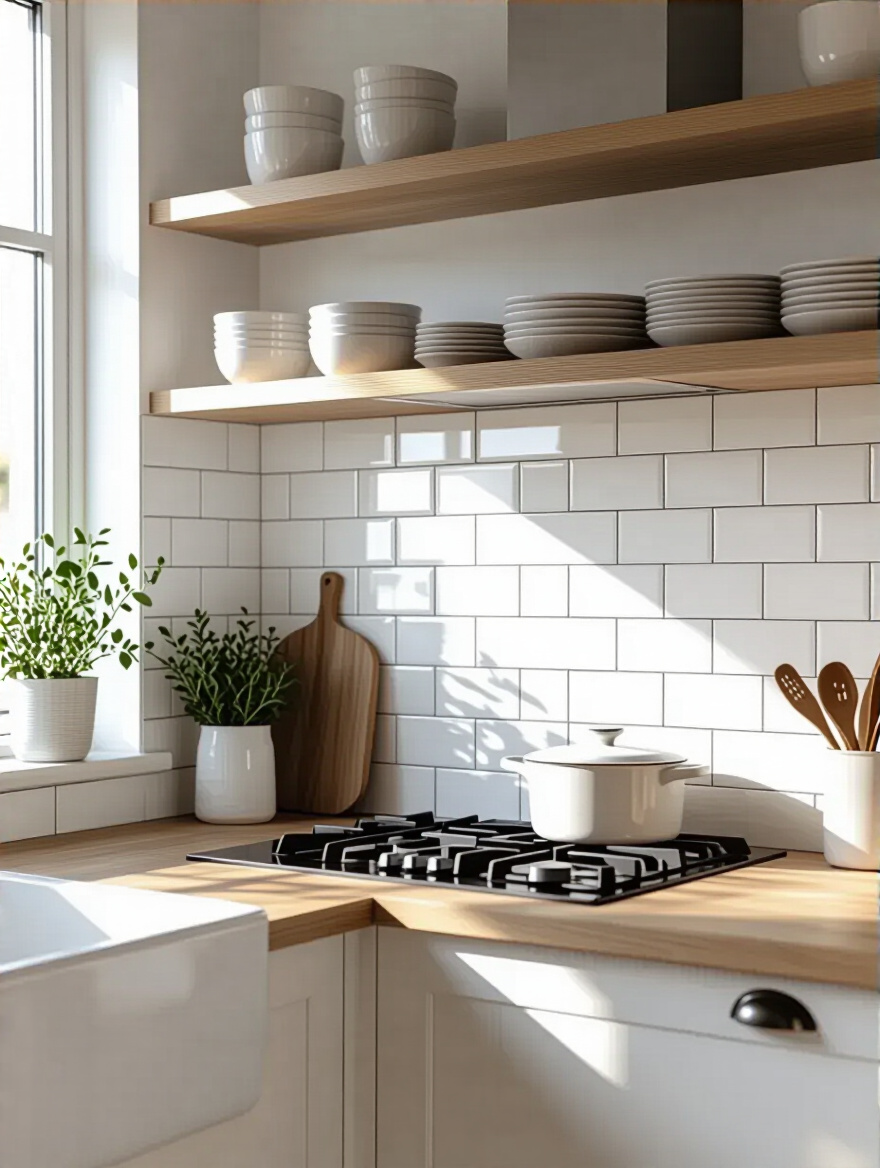
Here’s the thing everyone gets wrong: the grout. People are obsessed with using dark, contrasting grout for a bold, graphic look. In a true Scandinavian-inspired space, that’s just more visual noise. The shortcut to serenity is to match the grout to the tile as closely as possible—a light grey or pure white. This allows the tiles to blend into one unified, calm surface rather than a busy grid.
This same principle of simple, classic form applies to your biggest feature: the cabinetry.
Shaker cabinets are the little black dress of kitchens. They are timeless, elegant, and incredibly versatile. Their beauty lies in their simplicity—that clean, recessed panel design is functional, unadorned, and honest. It’s a design that has lasted for centuries because it’s rooted in craftsmanship, not trends.
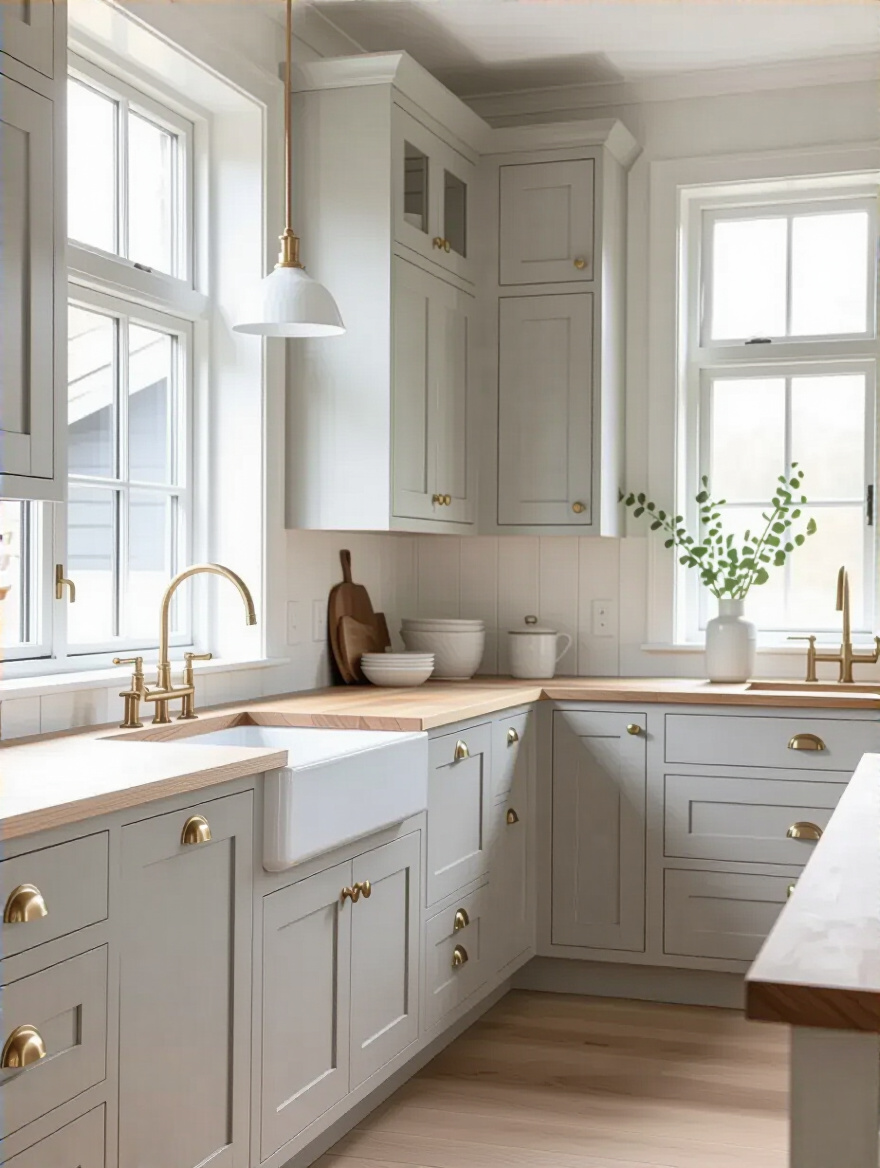
When painted in a soft, muted color—a gentle off-white, a soft grey, a dusty green—they become the perfect canvas for a Scandinavian kitchen. They provide a subtle layer of dimension without being ornate. Just pair them with simple, understated hardware (like matte knobs or simple pulls) and you have an instant sense of quiet, enduring style that will never feel dated.
Now that the aesthetic foundation is set, let’s talk about making it all work seamlessly in your daily life.
A serene kitchen is an organized kitchen. This is where we ensure the space flows effortlessly, furniture invites connection, and clutter stays hidden, preserving the peace.
Scandinavian design is all about connection—to nature, to light, and to each other. An open layout removes the physical barriers between the kitchen and the living areas, allowing for conversation and energy to flow freely. The person cooking isn’t isolated; they’re part of the action. It makes the kitchen truly the heart of the home.
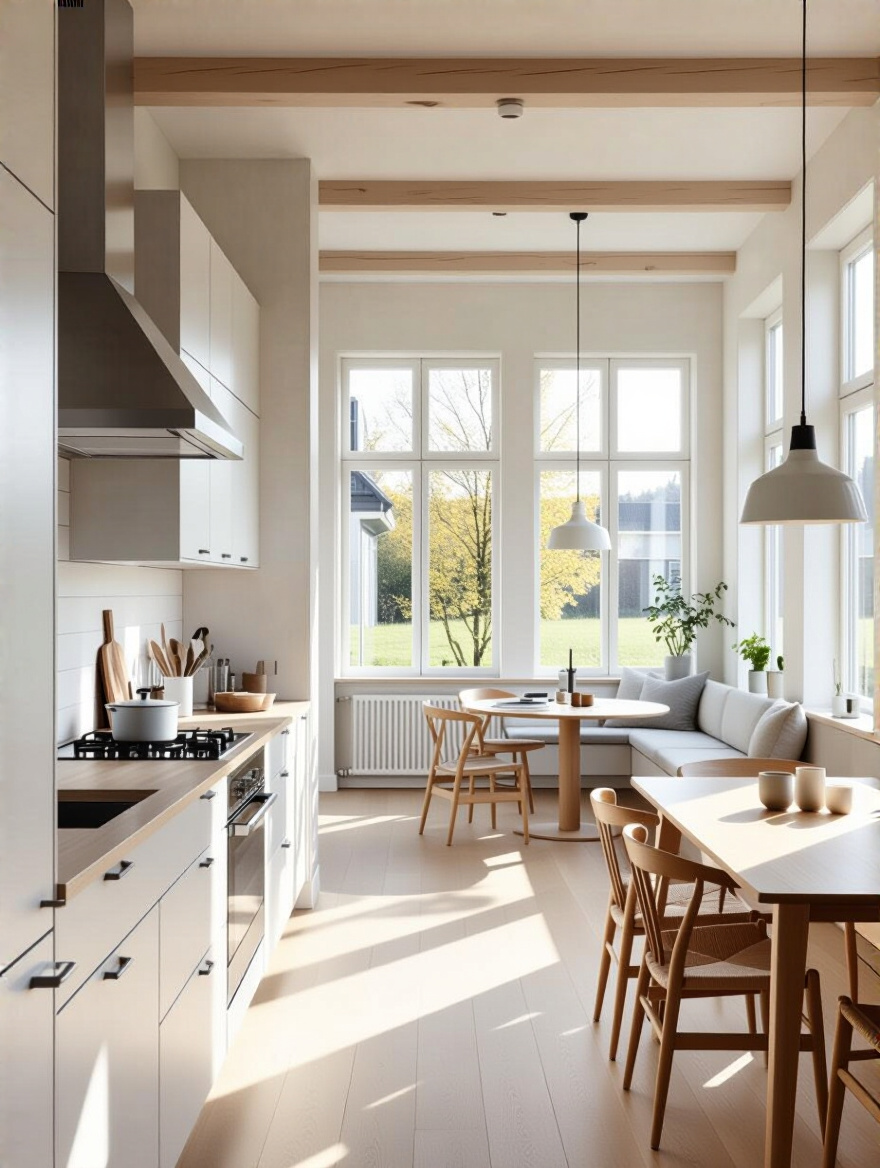
The mistake I see is creating one big, undefined cavern. You still need to create “zones” using subtle cues. A large pendant light can define the dining area. A beautiful rug can anchor the living space. A kitchen island can create a soft boundary for the cooking zone. This way, you get the social benefit of openness without sacrificing the sense of purpose for each area.
An island, in particular, becomes the functional and social hub of this open space.
In a Scandinavian kitchen, an island isn’t a bulky piece of furniture; it’s a sleek, multi-functional workhorse. It’s where you prep food, gather for a glass of wine, or help with homework. The key is to keep its design light and airy. Think clean lines, uncluttered surfaces, and “waterfall” edges where the countertop material flows down the sides for a seamless look.
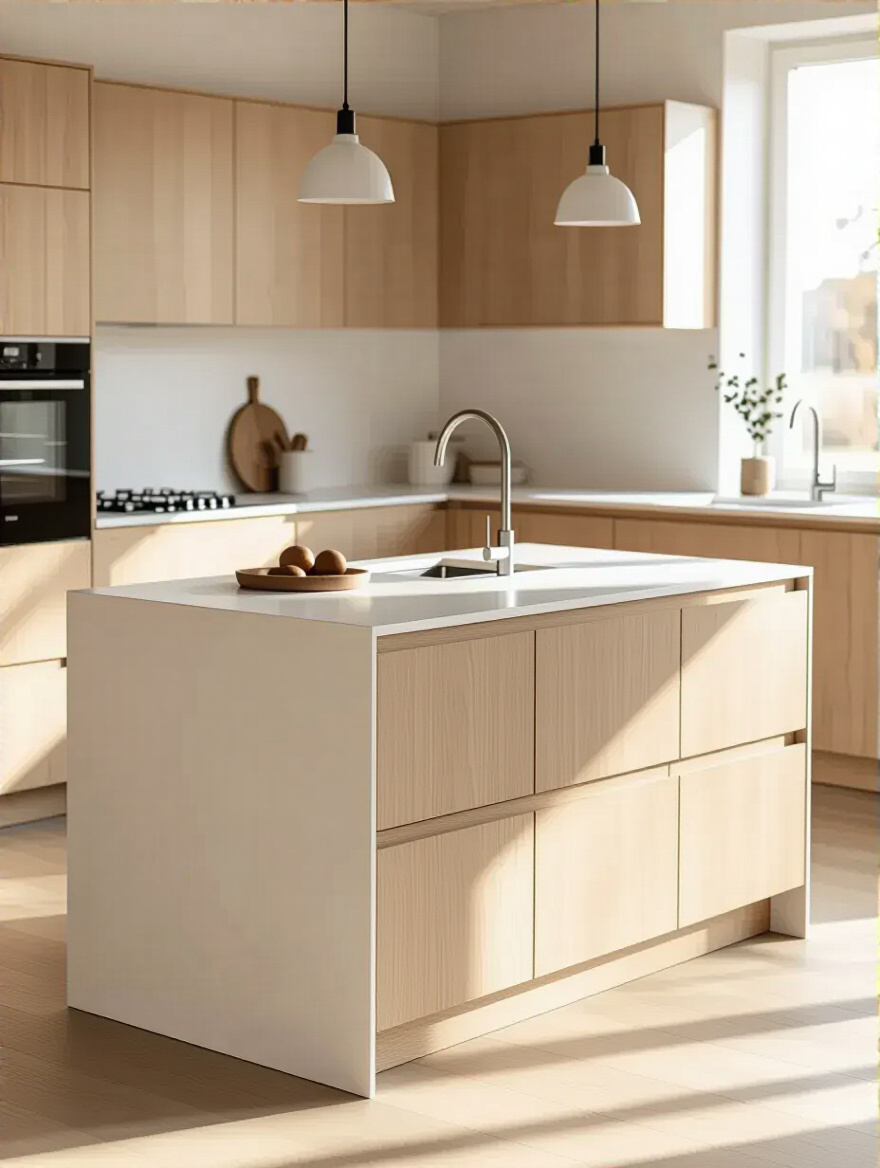
The goal is to make it look like it’s effortlessly floating, not weighing down the room. This means choosing a simple design without a lot of fussy details or ornate carvings. Often, the most beautiful islands are the ones that blend in, continuing the same material and color as the main cabinets, creating a single, harmonious unit.
The same principle of “lightness” applies to the seating you choose for that island.
This is a game-changer. Look at your current kitchen chairs or stools. Do they have a solid, heavy base that sits right on the floor? Or do they have slender legs that lift the seat up, allowing you to see the floor underneath? Choosing legged seating is a powerful way to create a feeling of spaciousness and airiness.
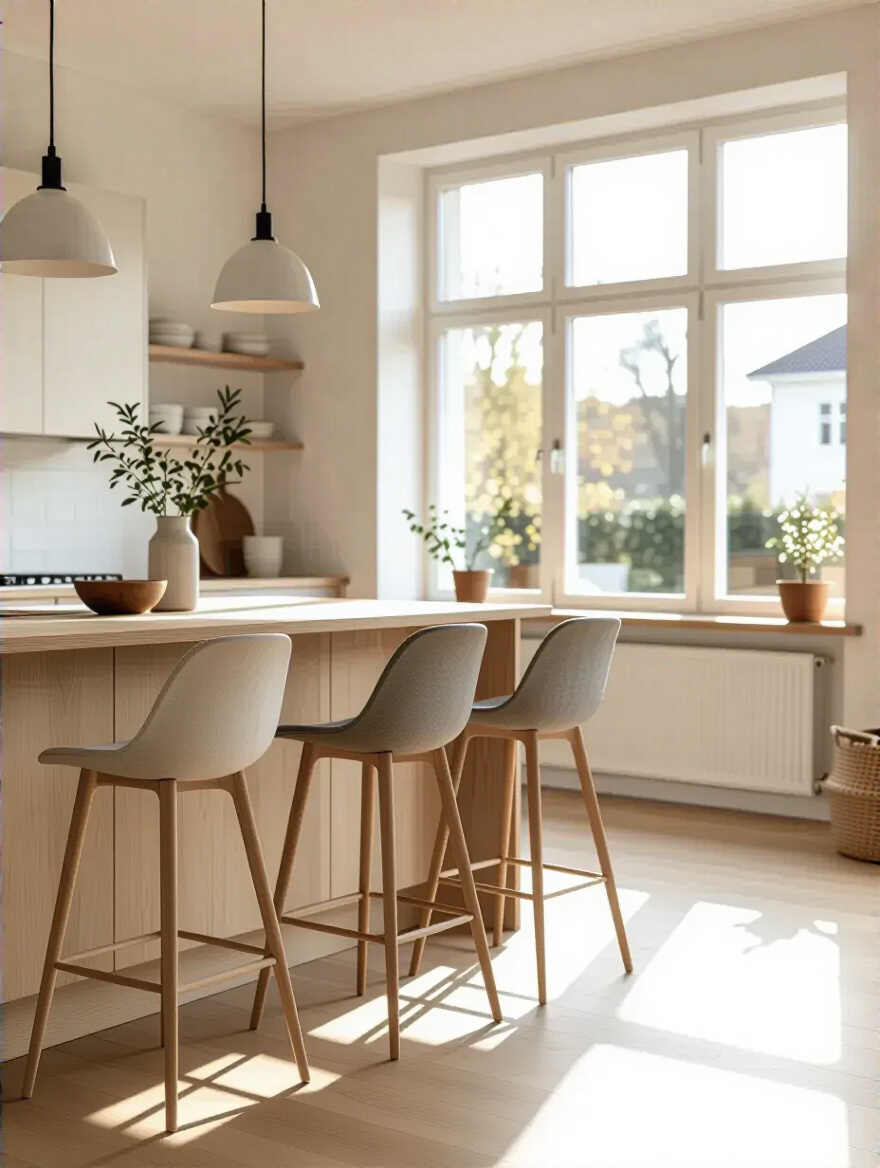
When light and air can flow under and around your furniture, the entire room feels lighter and less crowded. It’s a simple visual trick with a profound psychological impact. Think of classic designs like the Wishbone chair or simple stools with thin wooden or metal legs. They do their job without taking up a lot of visual real estate, which is the essence of mindful design.
Now, let’s talk about hiding the things we don’t want to see.
There is nothing more disruptive to a serene, clean-lined kitchen than a hulking stainless-steel refrigerator. Integrated appliances—where your fridge, dishwasher, etc., are hidden behind panels that match your cabinetry—are the ultimate move for a calm, uncluttered look. They allow the kitchen to read as a single, cohesive piece of furniture rather than an assortment of machines.
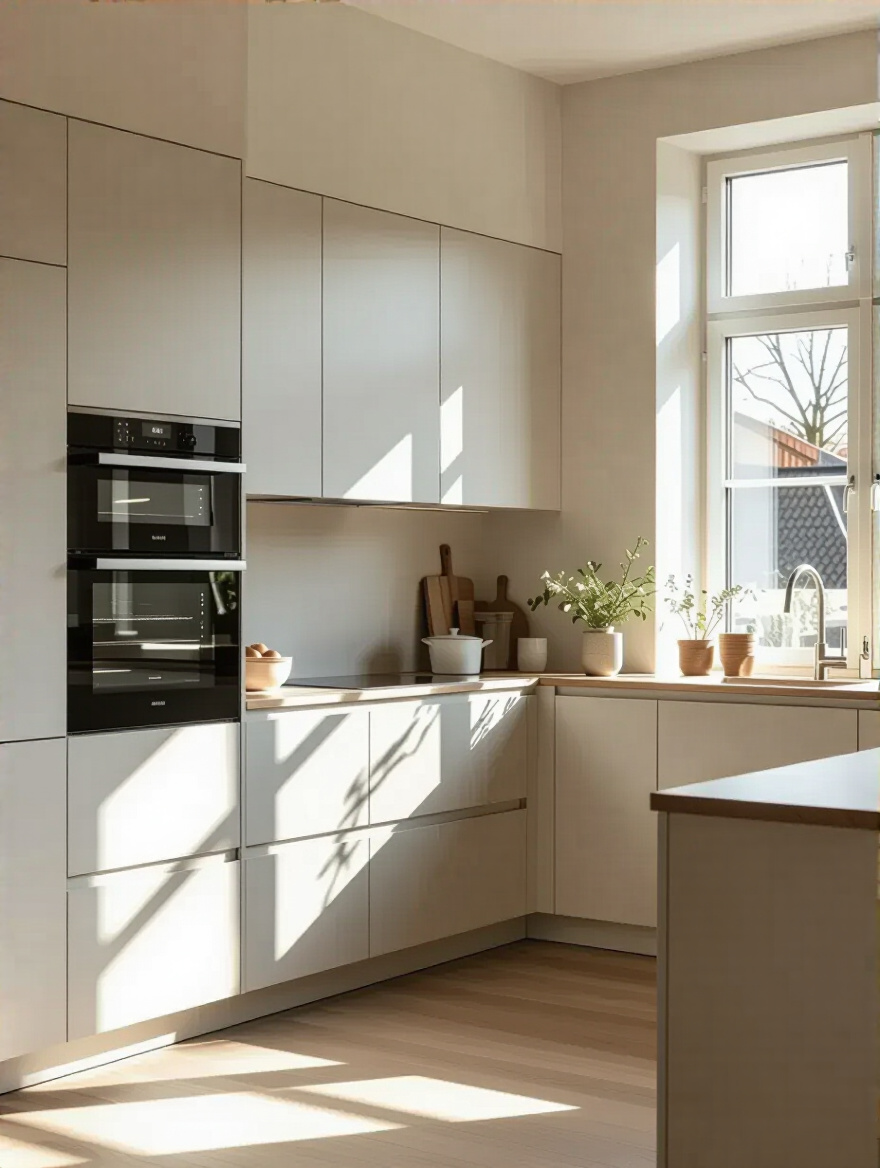
I know this is a bigger investment, but it makes a world of difference, especially in an open-concept space. The visual flow is completely uninterrupted. The BS is that it’s just for high-end designers. Brands like IKEA have made this much more accessible. It creates a space that feels less like a utilitarian workshop and more like a peaceful living area.
Behind those seamless panels, organization is everything.
A serene Scandinavian kitchen looks empty, but it’s not. It’s just brilliantly organized. The secret is maximizing every single inch of storage so that clutter never has a chance to land on your countertops. Think deep drawers with custom dividers for pots and pans, pull-out pantries for dry goods, and clever corner units that bring everything to you.
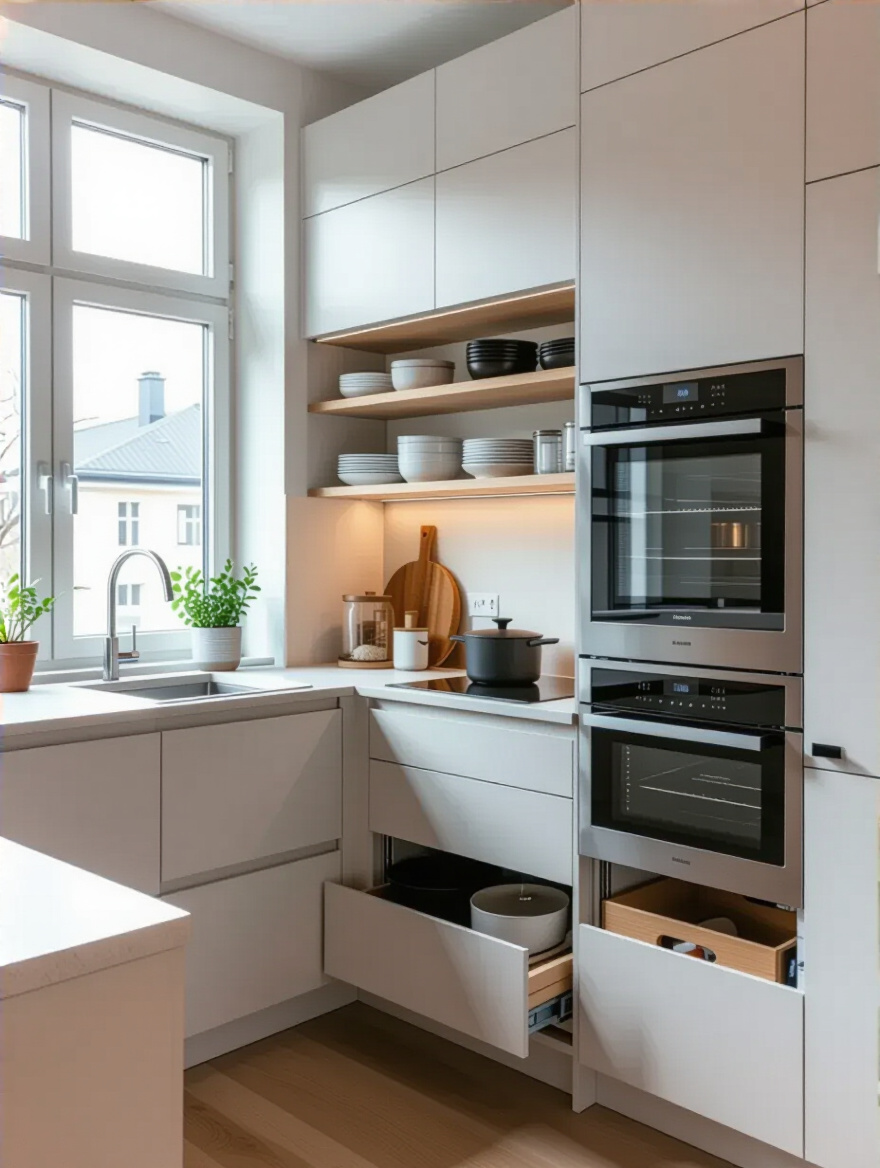
My favorite shortcut for this is to do a “clutter audit.” Where does clutter consistently pile up in your kitchen? That’s the spot that needs a better storage solution. Is it the mail on the counter? You need a designated mail slot inside a cabinet. Is it the small appliances? You need an “appliance garage.” A place for everything, and everything in its place—it’s an old saying, but it’s the gospel of a peaceful kitchen.
With everything organized, we can turn our attention back to light—this time, the artificial kind.
Light is a tool. We use it to guide the eye, set the mood, and make the space functional. Here’s how to layer light to create that signature bright-yet-cozy Scandinavian feel.
We talked about letting light in, and that means keeping window treatments to an absolute minimum. If you need privacy, opt for something that feels light and airy. Sheer linen curtains that diffuse light beautifully, a simple roller blind that disappears when it’s up, or café curtains that cover only the bottom half of the window are all perfect choices.
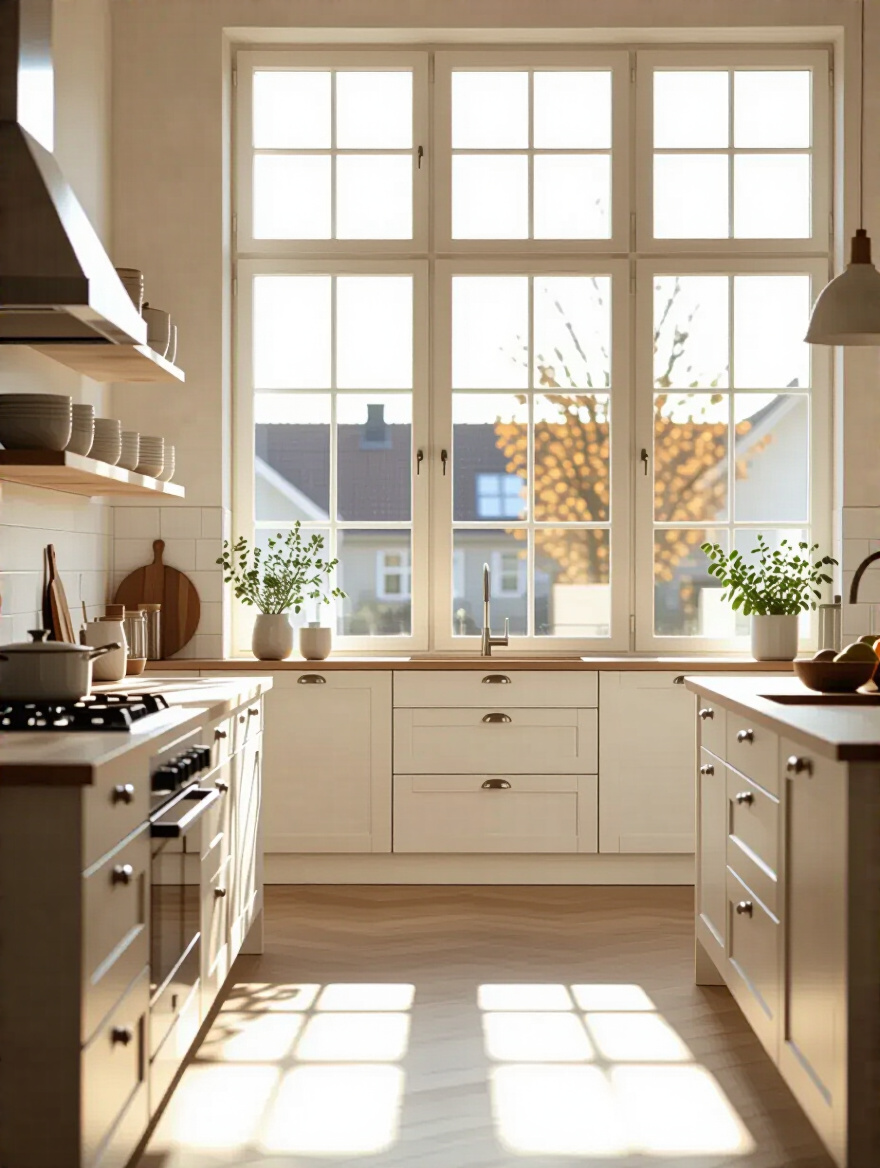
The big mistake is using heavy drapes or fussy blinds that add visual weight and block the edges of the window, making it feel smaller. The goal is to frame the view and the light, not to hide it. Often, the most beautiful solution is no treatment at all, letting the architecture and the natural light speak for themselves.
Now we’ll add our own sources of light to complement what nature provides.
Pendant lights in a Scandinavian kitchen are like jewelry. They should be chosen with care, because they serve as both functional task lighting and a piece of art. A beautiful, sculptural pendant hanging over an island or a dining table creates a focal point and anchors the space. It draws people in and creates a hub of activity.
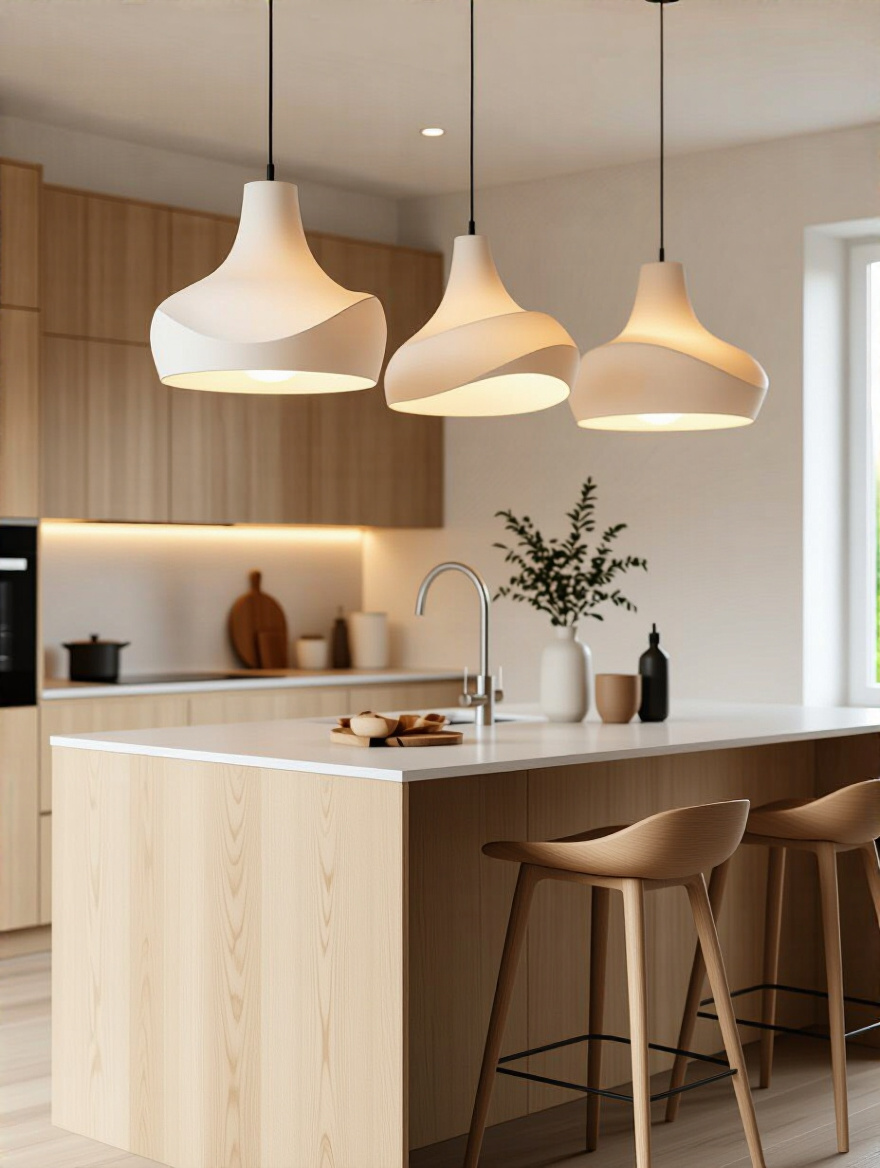
Choose pendants with simple, organic forms and natural materials like wood, opal glass, or matte metal. The key is to hang them at the right height—low enough to illuminate the task at hand without blocking sightlines across the room. I love the iconic designs from Louis Poulsen, but you can find beautiful, simple pendants at all price points. A single, well-chosen pendant is often all the “decoration” you need.
But one light source is never enough.
Relying on a single, harsh overhead light is the number one killer of atmosphere. A well-lit kitchen needs layers. Think of it like this: first, you have your ambient light (the general, overall light from recessed cans or a flush-mount fixture). Then you add task light (like pendants over the island and under-cabinet lights). Finally, you add accent light (a small lamp in a corner or a light to highlight art).
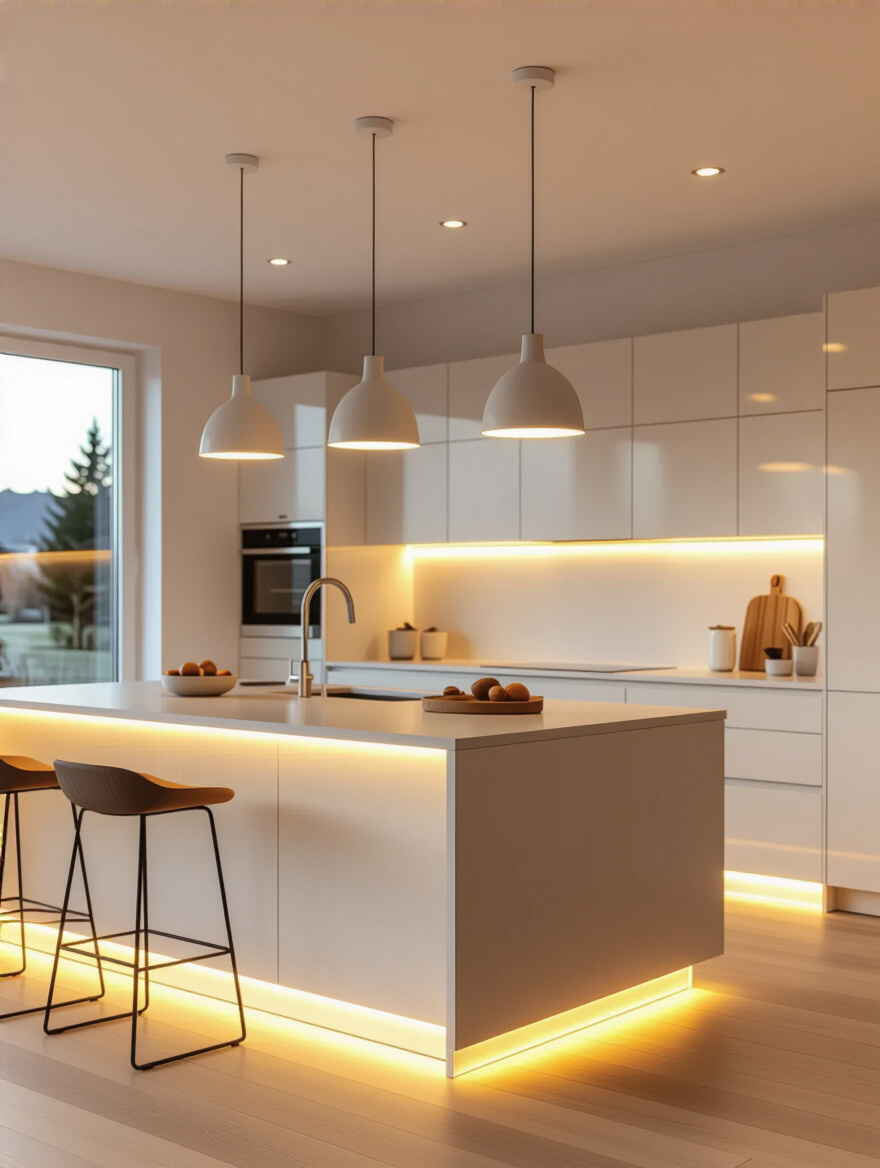
The most important part of this is putting everything on a dimmer. All of it. This gives you complete control. You can have it bright and energetic while you’re cooking, then dim it all down for a cozy, intimate dinner. This flexibility is what allows your kitchen to transition from a workspace to a relaxing sanctuary.
The quality of that light is just as important as the source.
This is such an easy fix, and it changes everything. Have you ever been in a space that just felt… harsh? It was probably lit with cool, blue-toned light. To create that warm, inviting ‘hygge’ feeling, you need warm-toned bulbs. Look for LEDs with a color temperature between 2700K and 3000K. This mimics the warm, golden glow of candlelight or an old-fashioned incandescent bulb.
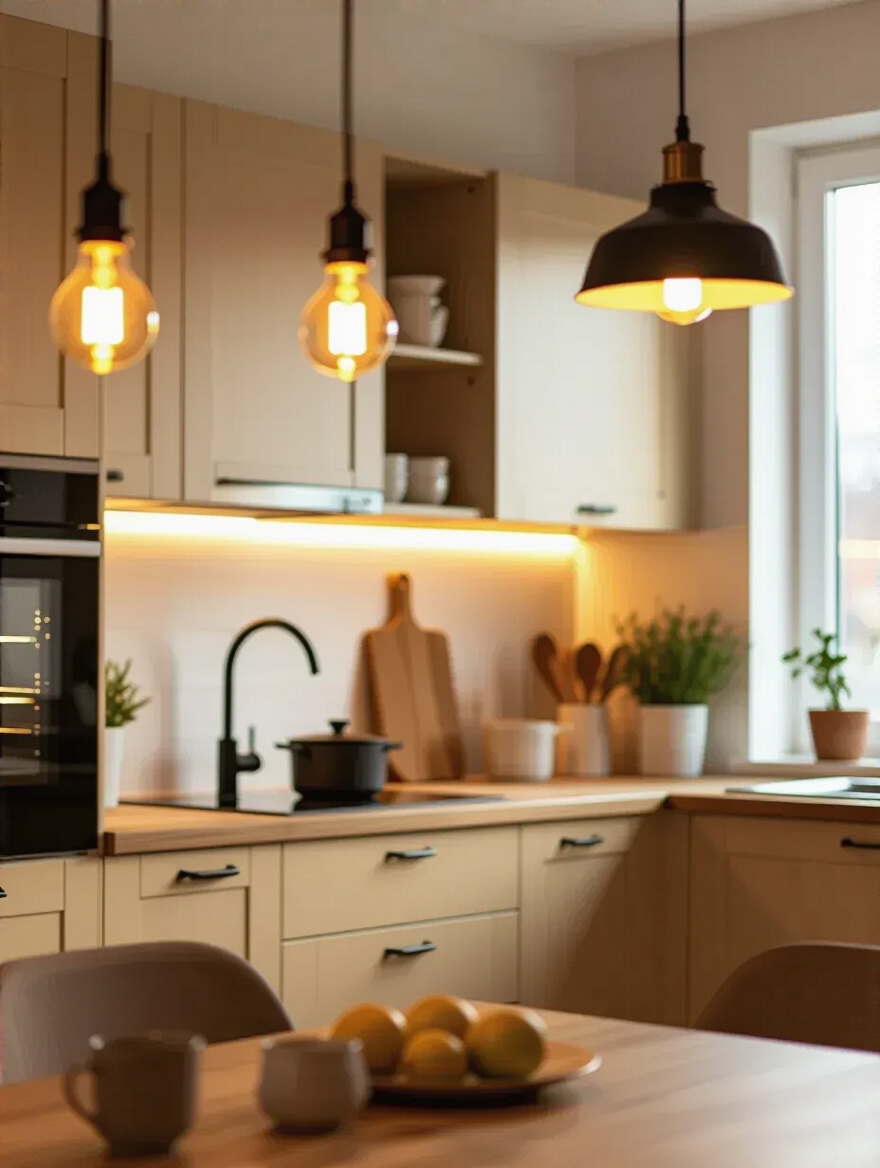
I used to think this was a minor detail, but then I helped a client who was stressed out in her kitchen every evening. We simply swapped all her cool white bulbs for warm white ones. The next day, she called me and said, “It’s like my kitchen gave me a hug.” That’s the power of warm light. It soothes our nervous system and signals our body that it’s time to unwind.
The last layer of light is one that is purely functional, yet adds so much beauty.
This is non-negotiable for a truly functional kitchen. Overhead lighting casts a shadow on your countertops exactly where you’re trying to work. Under-cabinet lighting illuminates your entire workspace, making chopping, prepping, and cleaning so much easier and safer. It eliminates those dark corners and makes the whole kitchen feel brighter and more open.
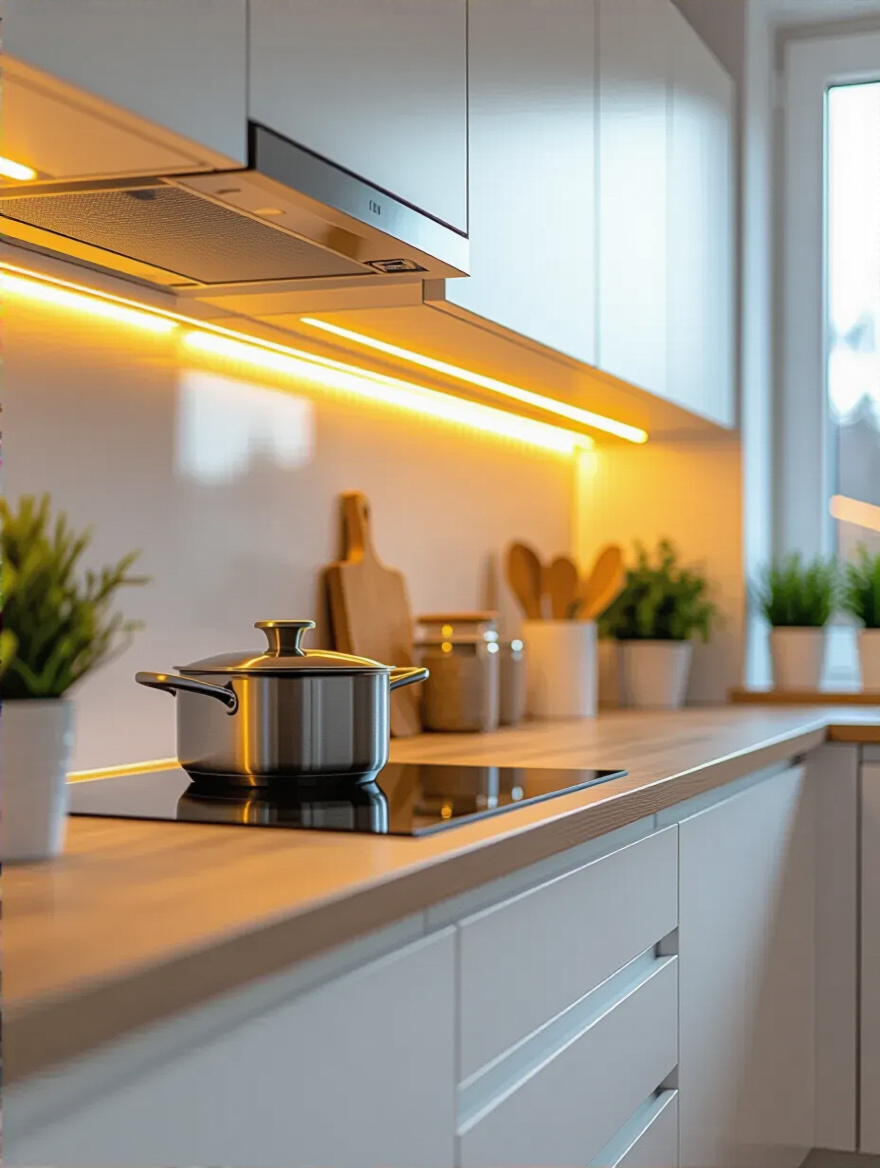
But it’s also an atmospheric tool. At night, you can turn off all the overhead lights and just leave the under-cabinet lighting on. It creates a beautiful, soft glow that highlights your backsplash and makes the kitchen feel peaceful and serene. It’s the perfect nightlight for a late-night cup of tea.
With the space perfectly lit, we add the final, personal touches.
This is the fun part. A serene space isn’t a sterile one. It’s a space that reflects you. This is where we add life, softness, and personality to make the kitchen uniquely yours.
A room without life is just a box. Plants are the easiest way to bring vitality, color, and organic shape into a minimalist space. They are a living, breathing connection to the natural world that softens all the hard lines and surfaces. A simple potted herb on the windowsill, a trailing pothos on a high shelf—they make a room feel cared for and alive.

The trick is to choose a few beautiful plants and place them intentionally, rather than having a jungle of tiny pots everywhere. Think of each plant as a living sculpture. My go-to for kitchens are snake plants (they’re nearly impossible to kill) and a simple pot of basil or mint, which offers both beauty and utility.
Next, we soften the hard surfaces with fabric.
In a room full of wood, stone, and metal, textiles are what make it feel like a hug. They absorb sound, add texture, and provide a soft touch. Think about a simple linen tea towel draped over the oven handle, a wool cushion on a dining chair, or a small, woven cotton rug by the sink.
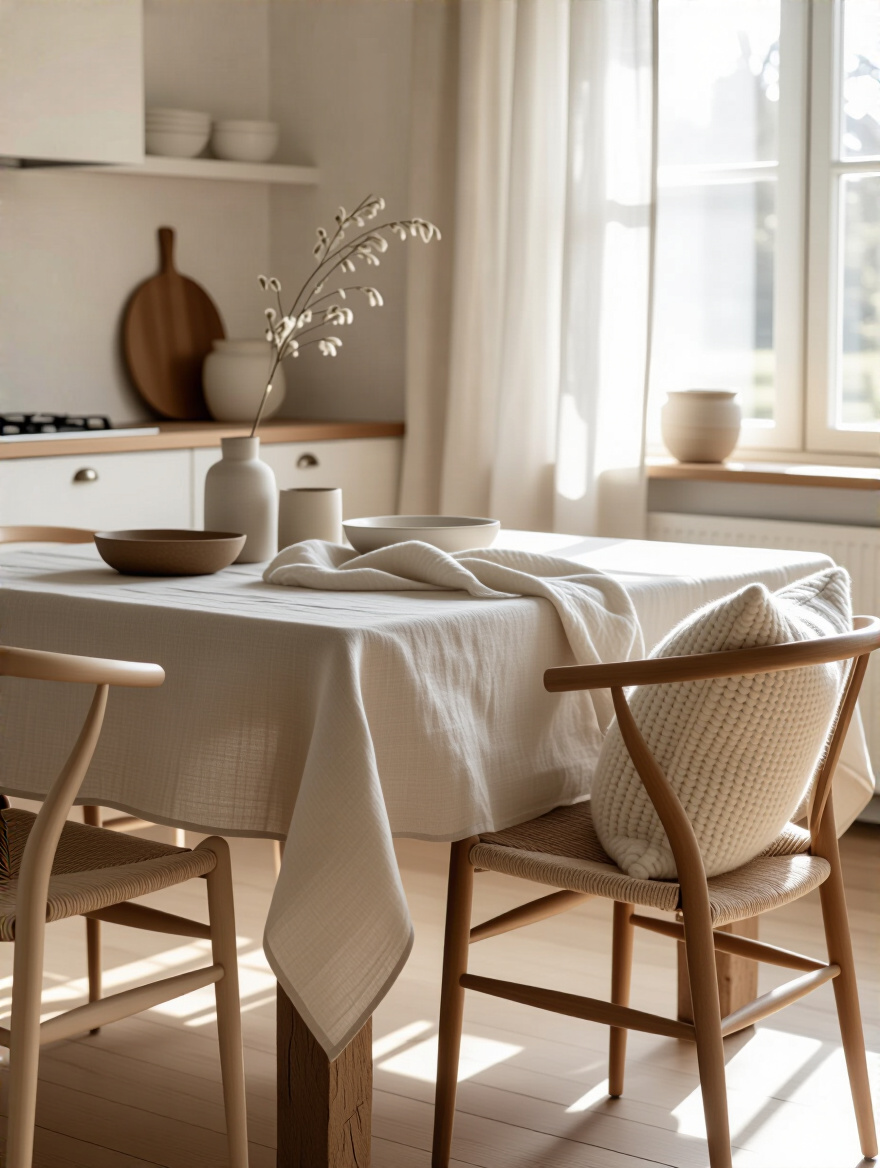
These aren’t just accessories; they are essential for creating comfort and that famous feeling of hygge. The key is to stick to natural materials—linen, cotton, wool, sheepskin. They have a beautiful, imperfect texture that synthetic fibers just can’t replicate. This is a shortcut to instant warmth, and it’s easy to swap them out with the seasons.
Now, let’s look at the things you already own with new eyes.
This is the heart of Scandinavian functionalism. The most beautiful objects are often the ones we use every day. Instead of hiding everything away, choose your most beautiful and practical items and display them thoughtfully. A cluster of wooden cutting boards leaning against the backsplash. Your favorite ceramic mugs on an open shelf. A beautiful bottle of olive oil next to the stove.
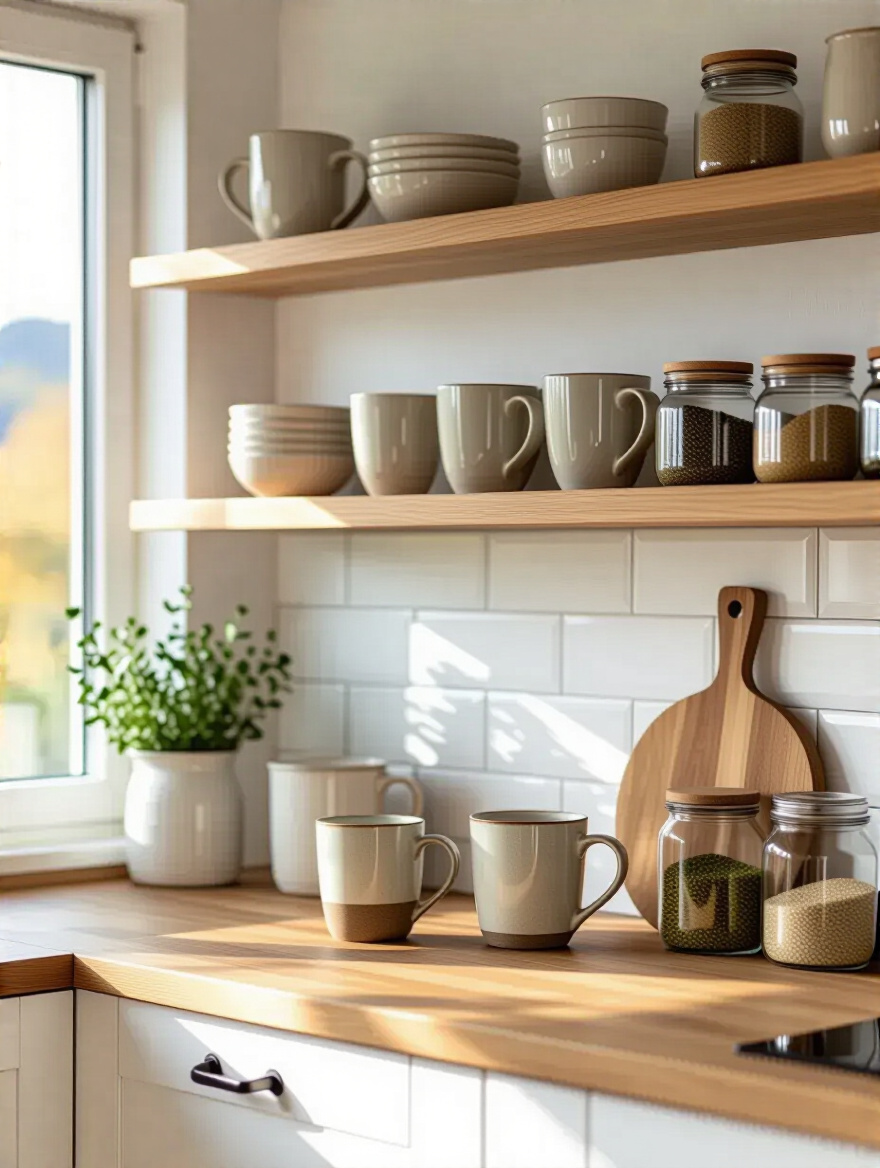
This isn’t about creating clutter; it’s about curated function. You’re celebrating the beauty in utility. I learned this the hard way when I tried to hide everything in a client’s kitchen. It ended up feeling lifeless. The moment we put her beautiful copper pots on a hanging rack, the kitchen came alive with her personality and passion for cooking.
Finally, we add the last layer: your story.
Even the most minimalist kitchen needs a soul. A small, carefully chosen piece of art is the perfect way to add personality and a focal point without creating clutter. It could be a simple, abstract print with muted colors, a black-and-white photograph of a meaningful place, or a small botanical drawing.
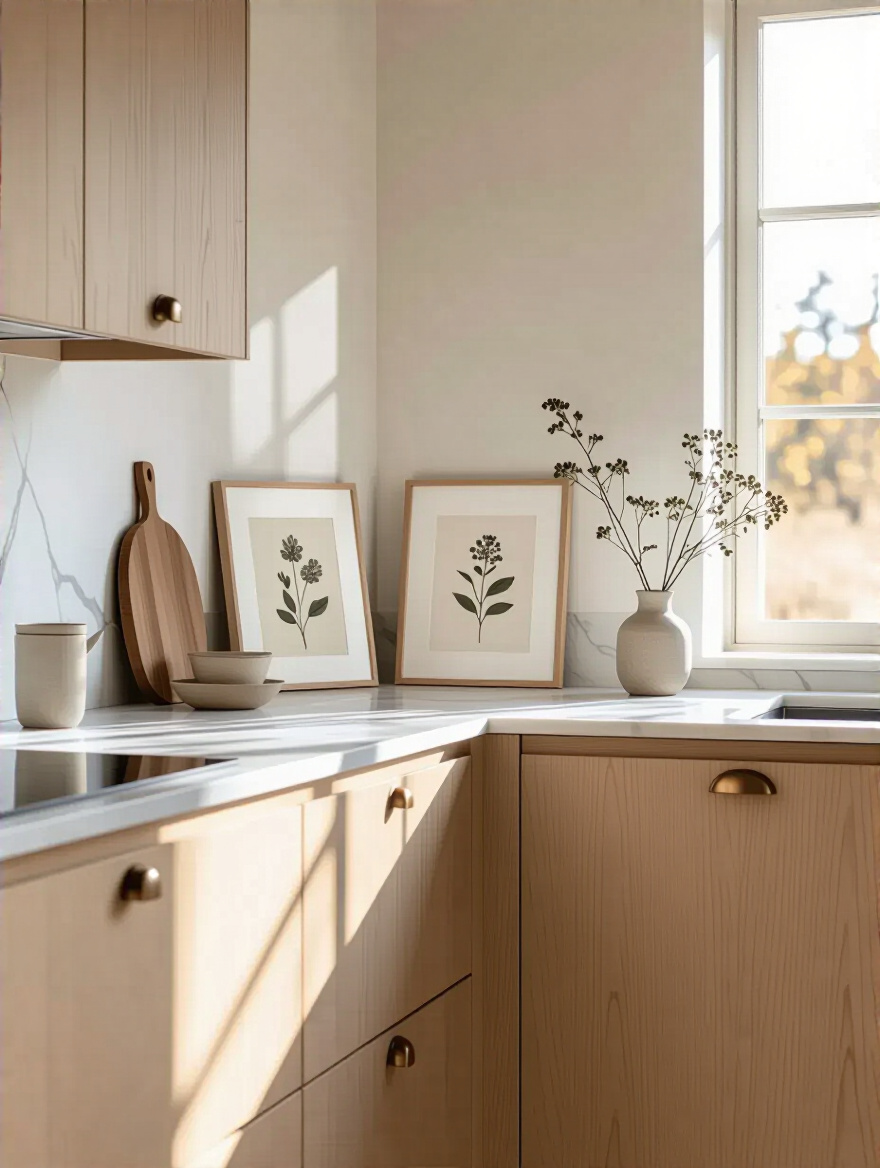
The key is “subtle.” You’re not looking for a massive statement piece that dominates the room. I love leaning a small framed print on an open shelf or against the backsplash. It feels casual, personal, and unfussy. The empty space around the art is just as important as the art itself. It gives it room to breathe, and it gives you a single, beautiful thought to rest your eyes on.
And there you have it. Creating a Scandinavian-inspired kitchen isn’t about following a rigid set of rules or buying a specific brand of furniture. It’s a practice of mindfulness. It’s about asking yourself, “Does this bring me peace? Is this truly useful? Is it beautiful?”
It’s about letting in the light, clearing out the noise, and making space for what truly matters: connection, nourishment, and a deep sense of calm in the heart of your home. Don’t feel like you have to do it all at once. Start with one thing. Swap out your lightbulbs. Buy a beautiful linen tea towel. Clear off one counter. Notice how it feels. With each intentional choice, you’re not just designing a kitchen; you’re cultivating a sanctuary. And you deserve that.